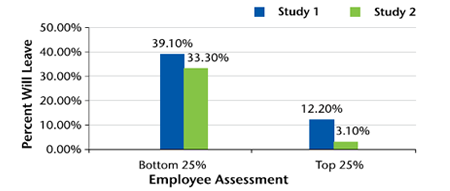Measuring the Business Impact of Employee Selection Systems to Improve Performance
Another interesting insight drawn from these studies was that highly qualified applicants were able to satisfy customers better than their low scoring counterparts. This, in turn, led to more spending by the customers and therefore, better financial profits for the organization.
Our analysis of other non-financial metrics has highlighted that having employees who fit well into an organizational culture have a lower tendency to leave the organization, eventually leading to cost savings in terms of reduced attrition. Therefore, an employment assessment tool can also lead to reduced turnover. Even though this does not relate directly to a financial impact on an organization, it is significant in improving productivity and reducing training investment. Hence we have therefore attempted to determineits future impact of reduced turnover in financial terms through reduction of operating cost of training new hires post attrition. Moreover, business impact of such metrics can be evaluated at a business unit levelA selection system's effectiveness can be ascertained in terms of non-financial qualitative metrics as well. Qualitative metrics can be seen as early indicators of organizational success. These qualitative aspects become quantifiable in the long run, fetching impressive financial
results for the organization. We have been able to trace the correlation of qualitative metrics to the employment behaviors that support the organizational strategy and that lead to effective financial results. A recent Aon Hewitt assignment has shown that high scoring candidates on assessments demonstrated a higher potential to deliver effectively on business results. Other studies also emphasized that high scorers were more likely to stay on-the-job and like the work they do as compared to the low scorers.
Employee Likelihood of Leaving

A comparison across two assignments demonstrated a greater likelihood of attrition for bottom performers on a pre-employment assessment over the top performers, as depicted in the graph above. Knowing in advance what kind of talent fits best and performs well in an organization helps with systematic selection of the most appropriate candidates. Acquiring people with the right qualities is eventually reflected in a magnified manner in the balance sheet. Therefore, companies should use a valid job-relevant assessment for effective selection of candidates. Hiring quality talent is one of the most crucial drivers of overall competence in any organization.
|